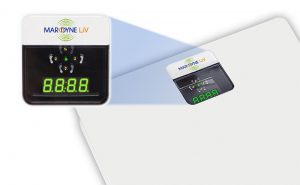Marodyne LiV is a safe scientific-based solution with these approved indications
Physical Therapy & Rehab
- Redevelops muscles
- Restores motion to joints
- Relieves minor muscle aches and pains
- Restores fast twitch action of Type IIA muscle fibers in?lower legs
- Restores dynamic action of calf muscle fibers
Bone & Muscle Health
- Safe & effective treatment for osteoporosis/penia
- Maintaining and/or increasing bone density
- Strengthens and increases muscle mass
- Stimulates blood & lymphatic flow
- For use as an adjunct treatment for obesity
The Marodyne Low Intensity Vibration (LIV) biomechanics vibration treatment system provides a gentle, yet highly effective, stimulus for muscles and bones. Its action is designed to build up bone mineral density and valuable bone substance as well as strengthening the core muscles and postural stability. It is easy-to-use, safe and reliable.
Low Intensity Vibration (LIV) treatment was developed by Professor Clinton Rubin of Stony Brook University, New York. His unique method delivers a very small mechanical vibration to stimulate a natural reaction in the body and signals to activate the cells of muscles and bones. People who are young and active, with a healthy muscle mass, create signals that are strong enough to stimulate these cells. However, people who are older, inactive or have poor muscle mass, produce slower signals which aren?t able to stimulate these cells: by using Marodyne LIV, stronger signals are created.
Now offering 30-day money back guarantee. Finance Available from $61.00/week or $122.00/fortnight. Contact us at info@rehacare.com.au for details

Bones and muscles respond to dynamic loading and forces. Apply them or take them away and the tissue will respond accordingly
1. Musculoskeletal deconditioning, that can occur through aging or disability, increases the risk of fractures. Exercise, such as walking and running is known to help maintain a good muscle and bone health. But these strategies may not be possible for frail, disabled or more elderly people. Low-intensity vibration, an acceleration of less than 1 gravity (g=acceleration of 9.81m/s2 and frequency greater than 30Hz) is a safe approach to this problem
2.Bones respond to both large low frequency and small high-frequency forces and grow more bone as a result. Taking away such forces increases the resorption of bone
3. Muscle is similarly affected. As we age the faster contracting muscle fibers (10-50Hz) decline proportionately
4. This can lead to greater musculoskeletal instability and poorer quality. LIV acts as an alternative to these high frequencies small sized forces
5. In scientific studies at a cellular level, LIV has been shown to stimulate bone formation cells (osteoblasts), while reducing production of fat cells
6. It also reduces the activity of bone resorption cells (osteoclasts).
LIV and Musculoskeletal conditioning
There are a number of human trials that evaluate the use of LIV as we age. In a placebo controlled trial in post-menopausal women LIV was shown in the women with high compliance to reduce loss of bone mineral (BMD) in the femoral neck, (Rubin 2004). In pre-menopausal women using LIV over 12 months, bones (hip and spine) and muscle in the lower back showed increases using LIV, (Gilsanz 2006). In adults with Thalassemia six months of LIV use showed significant increases in whole body bone mineral content (BMC) and BMD, (Fung 2012).
A large study in 710 women over 60 years using LIV for 18 months, showed reductions in falls and fractures in the group using LIV compared to controls, (Leung 2014). There were significant benefits in muscle strength and balance and some bone benefit using LIV. The study concluded that LIV is effective in reducing falls and associated injuries.
Bone loss in Children
LIV provides a safe non-pharmacological intervention for children and young people with osteoporosis. Children with disabling conditions, including cerebral palsy used LIV for six months and showed 18% benefit in tibial bone quality compared to control (Ward 2004). A second study showed increases in cortical bone strength after six months of LIV use, (Wren 2010). This is important to reducing fracture risk. In a more recent placebo controlled study in boys with Duchenne muscular dystrophy very significant bone improvements were seen from LIV use over 12 months, (Bianchi 2013). In girls with adolescent idiopathic scoliosis LIV was used for 12 months and significant BMD increases were shown in the femoral neck as well as increase in lumbar spine bone.
Is it safe?
The low-intensity vibration signal delivered by LivMD is considered safe* for up to 4 hours of exposure per day according to?the International Safety organization (ISO) threshold for human tolerance of vibration, ISO-2631.?OSHA (The Occupational Safety and Health Administration) and the ISO have come out with specific advisories on duration?thresholds for human tolerance, which is dependent on both frequency and duration. In the figure from ISO-2631, it shows
time (horizontal), and acceleration (vertical), with the dark ?hockey-sticks? indicating how much time you can safely be?exposed to these signals.
Ideal uses for Low Intensity Vibration treatment
To treat and prevent osteoporosis ? by building bone density.
To reverse the effects of physical inactivity in people who are disabled, ill or convalescing ? by building up core muscles and encouraging blood circulation.
To help the elderly ? by addressing age-related muscle weakness, improving posture and balance to helping in falls prevention.
To redress the effects of degeneration of joint, cartilage, bone and nerve tissues (commonly seen in osteo arthritis and Parkinson?s Disease) ? by easing pain and improving posture, stability, equilibrium and balance.[/vc_column_text][/vc_tta_section][vc_tta_section i_type=”openiconic” i_icon_openiconic=”vc-oi vc-oi-play” add_icon=”true” title=”FAQs” tab_id=”1508929408481-c7bb01be-d26e”][vc_column_text]Do you have osteoporosis?
Would you like to have stronger bones?
Would you like to improve your posture?
If you answered yes to any of these questions, you should try the Marodyne Low Intensity Vibration (LIV) device. This medication-free, tried and tested treatment has been documented in numerous scientific studies to address and reverse the symptoms of osteoporosis by increasing bone density and strength to help improve posture and mobility.[/vc_column_text][vc_column_text]What is Low Intensity Vibration therapy?
LIV should not be confused with Whole Body Vibration which exerts a high acceleration, high level vibration of over 1g, carries a high potential risk and has many contra-indications.
Low Intensity Vibration provides a precise, low acceleration, low level vibration of 0.4g which is transmitted at a high frequency (30hz). LIV mimics the small high frequency forces that occur naturally in young, healthy, active people?s bodies.[/vc_column_text][vc_column_text]How does LIV therapy work?
Bone and muscle cells are very small in comparison to the whole bone or muscular system. Therefore, only small, specific stimuli are needed to activate the bone and muscle cells and stimulate new growth. The Marodyne LIV treatment system delivers these small, targeted stimuli to have the desired effect.[/vc_column_text][/vc_tta_section][vc_tta_section i_type=”openiconic” i_icon_openiconic=”vc-oi vc-oi-play” add_icon=”true” title=”Research & Science Support” tab_id=”1508929409663-5ba92a35-1de3″][vc_column_text]
How to enhance muscle and bone health
Message from Dr. Clinton Rubin
 I have spent the entire 30 years of my scientific career trying to understand how mechanical signals influence the musculoskeletal system. One of our key findings has been that extremely low magnitude mechanical signals, delivered in the form of LIV (Low Intensity Vibration), have the capacity to dictate the regeneration patterns of mesenchymal stem cells (MSCs) found within the bone marrow to stimulate the formation of bone and muscle and suppress the formation of fat.
I have spent the entire 30 years of my scientific career trying to understand how mechanical signals influence the musculoskeletal system. One of our key findings has been that extremely low magnitude mechanical signals, delivered in the form of LIV (Low Intensity Vibration), have the capacity to dictate the regeneration patterns of mesenchymal stem cells (MSCs) found within the bone marrow to stimulate the formation of bone and muscle and suppress the formation of fat.
We have discovered, through our many years of scientific research in preclinical and clinical studies, that low intensity vibration promotes bone quantity and quality, builds lean muscle mass and the conditioning of muscle reflexes. It is the goal of all biomedical scientists to see the work that we do in the laboratory translate to the clinic, to help the health and well-being of patients. It is very exciting, indeed, that we are finally achieving this goal. Thank you for considering the Marodyne LIV technology as a potential means of restoring and protecting bone and muscle health. It has been a long scientific journey, but we are very, very pleased to see the application of this technology become a reality.
Best Regards
Clinton Rubin
Scientific direction
Solid, scientific experience and substantiated results
The Marodyne LIV product draws on a solid, medical foundation. Known globally as the only provider of a fully medically certified (under the EU Medical Devices Directive), safe Low Intensity Vibration (LIV) platform, Marodyne is supervised by a scientific advisory board with leading experts from the fields of biomedicine, orthopaedics, osteoporosis, metabolism, rehabilitation medicine and stem cell research. The starting points for the development of the treatment were orthopaedics, osteoporosis and space medicine: the future of the research is increasingly determined by new studies and findings from the field of stem cell biology.
Prof. Dr. Clinton Rubin
 Professor Rubin serves as the Chief Scientific Officer at Marodyne LIV. He is also SUNY Distinguished Professor and Chair of the Department of Biomedical Engineering at the State University of New York at Stony Brook, and Director of the NYSTAR Center for Advanced Technology in Medical Biotechnology.
Professor Rubin serves as the Chief Scientific Officer at Marodyne LIV. He is also SUNY Distinguished Professor and Chair of the Department of Biomedical Engineering at the State University of New York at Stony Brook, and Director of the NYSTAR Center for Advanced Technology in Medical Biotechnology.His work is targeted towards understanding the cellular mechanisms responsible for the growth, healing and homeostasis of musculoskeletal tissues such as bone, cartilage, tendon, ligament and muscle, as well as the formation of adiposity (fat). [Remark: Homeostasis can be defined as a property of an organism or system that helps it maintain its parameters within a normal range of values – it is key to life] More specifically, this work focuses on how biomechanical stimuli mediate these responses through the control of mesenchymal stem cell differentiation and proliferation. The clinical significance of this work is applicable to the inhibition and reversal of loss of bone mass and bone density, osteopenia and osteoporosis, the promotion of bony ingrowth into implants, the acceleration of fracture healing, and the suppression of obesity and diabetes. Professor Rubin has published over 200 peer-reviewed papers and 50 book chapters on the use of physical stimuli in controlling physiologic processes and the musculoskeletal system.
Professor Rubin is a fellow of the American Institute of Biological and Medical Engineers and a recipient of the Presidential Young Investigator Award from the National Science Foundation, two Kappa Delta Awards from the American Academy of Orthopaedic Surgeons, the John Charnley Award from the Hip Society, the Fuller Albright Award from the American Society of Bone and Mineral Research and the Giovanni Borelli Award from the American Society of Biomechanics.
He is currently funded by National Institutes of Health, National Aeronautics and Space Administration, private industry and the New York Office of Science, Technology and Academic Research. Professor Rubin holds 22 patents, with 14 pending, in the areas of wound repair, stem cell regulation and treatment of bone disease.
Professor Rubin?s research into non-invasive, non-pharmacological intervention to control osteoporosis was referenced in National Geographic?s January 2001 article about surviving space travel. His studies show that the application of extremely low level strains will increase bone formation, and thus may represent the much sought-after “anabolic” stimulus in bone.
Weight: 9 kg Height: 6 cm
Length: 45 cm Width: 35 cm
User weight range: 23?125kg
Dimensions: 18″ w x 14″ deep x 2″ h (45.7 x 35.6 x 5.1 cm)
Power: 100-240 VAC
Frequency: 30 Hz
Vibration level: <1 mm
Max G force: 0.4 g
Warranty: Two year parts and labor[/vc_column_text][/vc_tta_section][vc_tta_section i_type=”openiconic” i_icon_openiconic=”vc-oi vc-oi-play” add_icon=”true” title=”Brochures” tab_id=”1508928460089-3cd0a384-2d3d”][vc_btn title=”Marodyne LiV Details” color=”success” size=”lg” align=”center” link=”url:https%3A%2F%2Fwww.rehacare.com.au%2Fwp-content%2Fuploads%2F2015%2F09%2FLivMD-Low-Intensity-Vibration-REV1a-Sept2015-Low-Resv1.pdf||target:%20_blank|”][vc_btn title=”Marodyne LiV Brochure” color=”success” size=”lg” align=”center” link=”url:https%3A%2F%2Fwww.rehacare.com.au%2Fwp-content%2Fuploads%2F2015%2F09%2FLivMD-EU-brochure-6_2015_REV2-SEPT2015-lo-rez.pdf||target:%20_blank|”][/vc_tta_section][/vc_tta_tour][/vc_column][/vc_row][vc_row full_width=”0″ full_height=”0″ particles=”0″ css=”.vc_custom_1508930081180{padding-bottom: 96px !important;}”][vc_column][vc_column_text]




